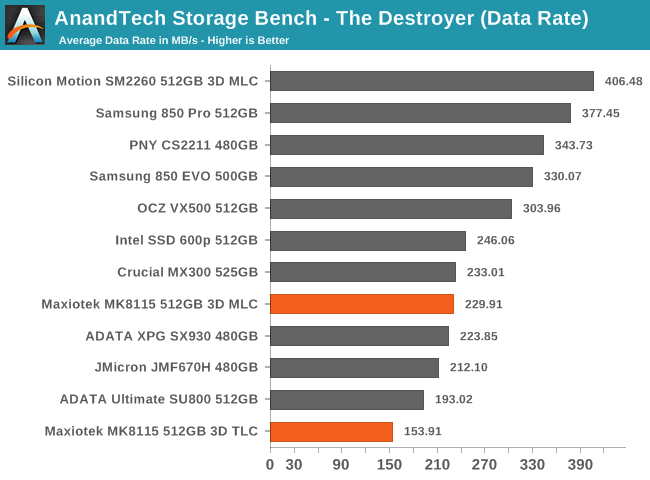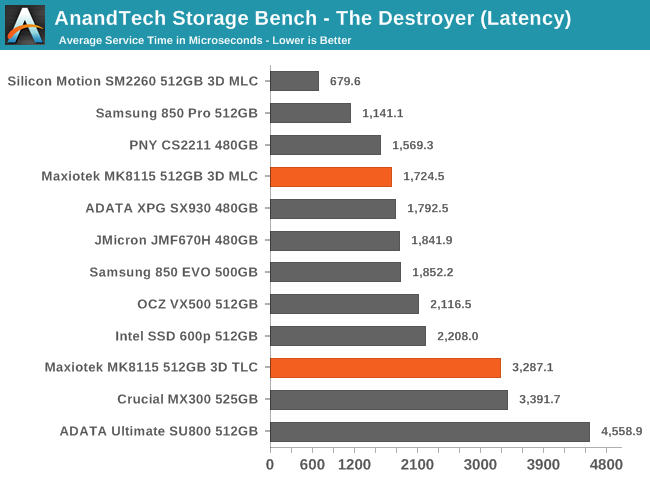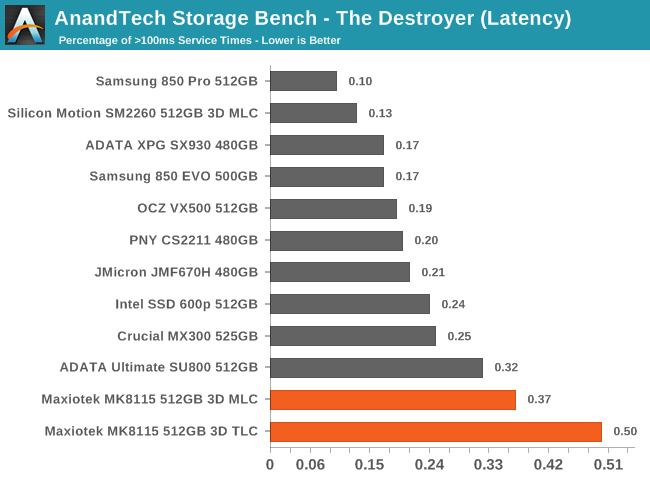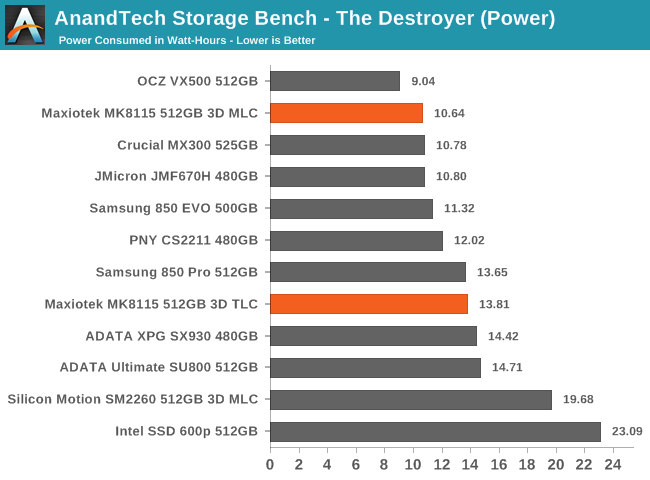Previewing Maxiotek's MK8115 SSD Controller: Can DRAM-less Drives Make The Cut?
by Billy Tallis on May 9, 2017 8:00 AM ESTAnandTech Storage Bench - The Destroyer
The Destroyer is an extremely long test replicating the access patterns of very IO-intensive desktop usage. A detailed breakdown can be found in this article. Like real-world usage and unlike our Iometer tests, the drives do get the occasional break that allows for some background garbage collection and flushing caches, but those idle times are limited to 25ms so that it doesn't take all week to run the test.
We quantify performance on this test by reporting the drive's average data throughput, a few data points about its latency, and the total energy used by the drive over the course of the test.

As expected, the MK8115 drives perform relatively poorly overall on The Destroyer. The TLC drive's average data rate is about 20% slower than the next slowest drive in this comparison. The MLC sample actually manages to slightly outperform the earlier JMicron drives, which weren't even handicapped by a lack of external DRAM. However, relative to current MLC drives, the MK8115 MLC drive is about 25% slower overall on this test.

The average service times of the MK8115 drives aren't particularly bad. The TLC drive's average service time is lower than either of the other two SATA drives using the same Micron 3D TLC. The MK8115 sample with MLC is slower than the Samsung 850 PRO and PNY CS2211, but slightly faster than the JMicron drives and the OCZ VX500.


The MK8115 drives do a decent job of keeping latency under control, with the MLC drive in particular having about the same number of outliers above 10ms as the best SATA SSDs. The MK8115 with TLC has some trouble but still has far fewer outliers above 10ms than the ADATA SU800.
However, when looking at the number of extreme latency outliers above 100ms, the MK8115 drives are the worst in the bunch and even the MLC drive scores worse than all the competing TLC solutions.

The power efficiency of the MK8115 drives is decent. Even though these drives take a bit longer to complete the test, the total energy used over the course of the test isn't any higher than most of the competition.










60 Comments
View All Comments
MajGenRelativity - Tuesday, May 9, 2017 - link
samevladx - Tuesday, May 9, 2017 - link
It will take until Q2 2018 for prices to start going down again.milli - Tuesday, May 9, 2017 - link
You should have included other DRAM-less drives.Billy Tallis - Tuesday, May 9, 2017 - link
I would have, if I had any on hand to test. Nobody's offered one up for review in quite a while, and I've asked a few vendors for a Phison S11 drive but they're not interested.vladx - Tuesday, May 9, 2017 - link
It's pretty obvious why, at least Maxiotek has some guts.bortiz - Tuesday, May 9, 2017 - link
My problem with dram-less ssd is the durability of the drive. How does the life-expectancy of this drive compare to other SSD drives. The DRAM in current SSD drives groups data accesses together, reducing the data array access. This increases performance and array durability. Array durability is proportional to the number of array accesses. I don't think this is a good idea and I would like to see if someone can prove to me that this will have a decent life span (5 years???)vladx - Tuesday, May 9, 2017 - link
Whether a SSD IS DRAM-less or not doesn't influence life expectancy.Billy Tallis - Tuesday, May 9, 2017 - link
SSDs that have external DRAM usually don't use it as a write cache for user data; it's just for caching the mapping metadata. A DRAMless controller like MK8115 can do pretty much the same amount of write combining and wear leveling that a mainstream controller can. There may be a slight increase in write amplification from the controller having to flush metadata updates to the flash more often, but mainstream drives don't want to buffer those writes too much either, for the same safety reasons they don't put user data in the DRAM.Remember that write operations are the only ones that significantly affect drive lifetime. DRAMless controllers need to do more flash reads, but read disturb errors are still too rare for that to matter to drive reliability.
CrazyElf - Tuesday, May 9, 2017 - link
It is difficult for it to make the cut with a low 4k random read and write test like this SSD has.I think that the DRAM cache is well worth it.
I think it is best to hold off on SSDs for now.
rocky12345 - Tuesday, May 9, 2017 - link
Yea no thanks if this is what DRAM-less drives are like I think I will stick to SSD's that can maintain their performance a lot better. I don't care if these drives are a bit cheaper if you end up swearing at your computer because the SSD is lagging then for peace of mind just spend the extra cash on a real SSD.I just sold a gaming system to a customer that had a SSD installed as the windows drive. Yep it booted fast and was pretty peppy but if you tried to work the system it seemed like the SSD would bog right down to a crawl so I would assume it was a DRAM-Less SSD. When I sold the customer on the system I was going off of my own SSD usage on my gaming laptop & gaming desktop options which would never bog down like that. I guess the good news was the customer did come back a few days later and said the system was great and so fast that he never had to wait for stuff to load like he did before on his older setup so he was a happy camper I guess.